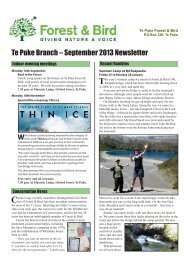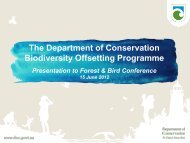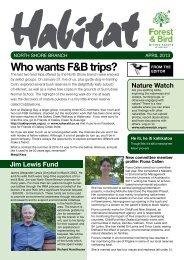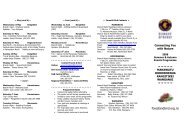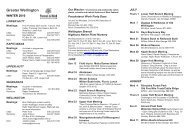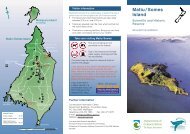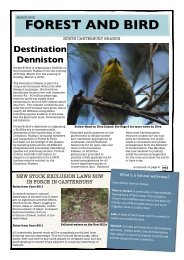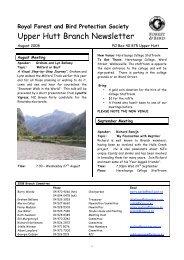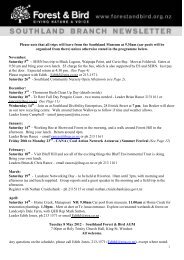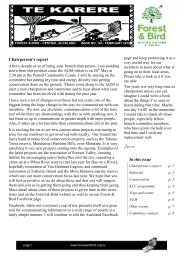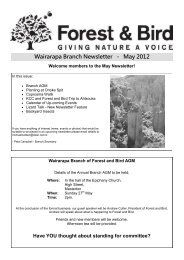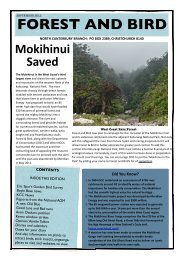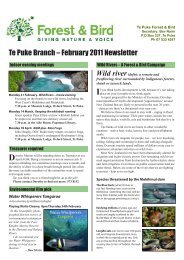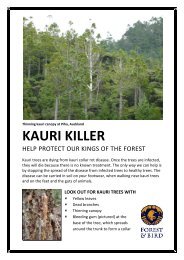Best Fish Guide 2009-2010 - Forest and Bird
Best Fish Guide 2009-2010 - Forest and Bird
Best Fish Guide 2009-2010 - Forest and Bird
Create successful ePaper yourself
Turn your PDF publications into a flip-book with our unique Google optimized e-Paper software.
Ling<br />
Scientific name: Genypterus blacodes<br />
Other names: hoka, hokarari, rari (Maori), ashiro, kingu<br />
(Japan), kingklip (South Africa).<br />
Ranking: E (Red - Avoid)<br />
Description: Ling is a bottom dwelling species of the eel family, which lives at depths of 300-700m throughout New<br />
Zeal<strong>and</strong>. It is often caught as bycatch in hoki <strong>and</strong> hake trawl fisheries, though it is also targeted with bottom longline<br />
<strong>and</strong> bottom trawl methods. The ling trawl <strong>and</strong> longline fishery is currently seeking environmental certification under<br />
an international body - the Marine Stewardship Council.<br />
Ecological concerns: Damage to fragile deepwater species <strong>and</strong> habitats caused by bottom trawling <strong>and</strong> the high<br />
level of globally threatened seabird species <strong>and</strong> NZ fur seals caught as bycatch. Also of concern is the unknown<br />
long-term sustainability of some current catch limits <strong>and</strong> l<strong>and</strong>ings, the uncertainty of stock boundaries, tthe lack of a<br />
management plan for the fishery <strong>and</strong> the loss of ling from diving depths.<br />
Economic value: The main export markets are in Asia, particularly Hong Kong <strong>and</strong> Japan plus Australia <strong>and</strong> Spain.<br />
Exports were worth $40 million in 2008.<br />
ASSESSMENT OUTPUT<br />
Biology <strong>and</strong> risk of overfishing (score C)<br />
Distribution: Ling is widespread in water off the south of the North Isl<strong>and</strong> <strong>and</strong> off the South Isl<strong>and</strong>, but is mainly caught south of the<br />
South Isl<strong>and</strong> <strong>and</strong> over the Campbell Rise at 200-700m.<br />
Maximum age (years): 30<br />
Age at sexual maturity: 5-9<br />
Growth rate: Variable.<br />
Reproductive output: Medium to low.<br />
Age exploited: 5<br />
Status <strong>and</strong> sustainability of fish catches (score C)<br />
Population size: Unknown for LIN 1 <strong>and</strong> LIN2 (most of the North Isl<strong>and</strong>) <strong>and</strong> uncertain for LIN 7 (West Coast South Isl<strong>and</strong>). Other<br />
areas (LIN 3, 4, 5 <strong>and</strong> 6) are likely above BMAY.<br />
Annual catch limit: The catch limit was set at 21,977 tonnes in 2003-04.<br />
Recorded catch: Reported l<strong>and</strong>ings of 16,264 tonnes in 2007-08, the third lowest catch in 15 years.<br />
Stock trends: Unknown for LIN 1 <strong>and</strong> LIN2 (non-Cook Strait), declining for LIN2 (Cook Strait); uncertain for LIN 7, declining slowly<br />
LIN 5 <strong>and</strong> 6, <strong>and</strong> increasing for LIN 3 <strong>and</strong> 4.<br />
MSY Status: Unknown for LIN 1 <strong>and</strong> 2, described as "sustainable" for LIN 3 <strong>and</strong> 4 <strong>and</strong> LIN 5, 6 <strong>and</strong> 7.<br />
The Ministry of <strong>Fish</strong>eries assessment plenary report states: For LIN1: “In the absence of a representative index of abundance,<br />
it is not known whether current LIN 1 catches or the TACC are sustainable. The state of the stock in relation to BMSY is unknown.<br />
The biological stock affinities of ling in LIN 1 are unknown..”<br />
For LIN 2 (Cook Strait – 40% of catch): “The model results … suggest that the stock has declined, particularly since the late 1980s.<br />
Based on the 2007 stock assessment current stock size is estimated to be above BMAY but is likely to continue to decline at current<br />
catch levels. It is not known if recent l<strong>and</strong>ings <strong>and</strong> the current TACCs are sustainable, or are at levels which will allow the stocks to<br />
move towards a size that will support the MSY [maximum sustainable yield].<br />
For LIN3 <strong>and</strong> LIN4: “Based on the 2007 stock assessment current stock size is estimated to be well above BMAY <strong>and</strong> building.<br />
Catches at the level of the current TACC are likely to be sustainable..”<br />
For LIN 5 <strong>and</strong> 6 (but not Bounty Plateau): “Based on the 2007 assessment ling stocks are probably only lightly fished <strong>and</strong> current<br />
stock sizes are estimated to be well above BMAY. Estimates of absolute current <strong>and</strong> reference biomass are unreliable... It is likely that<br />
the current TACC is sustainable, as current catches appear to be having only a small impact on biomass levels.”<br />
For LIN7 (West Coast): “Based on the 2008 assessment, the status of the LIN 7WC stock is highly uncertain. The stock assessment<br />
model results did not provide reliable estimates of current biomass as a percentage of B0, but it is unlikely that this value is less than<br />
40%, <strong>and</strong> it could be much higher. The relatively constant catch history since 1989 <strong>and</strong> the relative constancy of the trawl catch-atage<br />
distributions since 1991 suggest that future catches at the current level are sustainable, at least in the medium term.” (M<strong>Fish</strong>,<br />
<strong>2009</strong>, p466-467).<br />
Impact of fishing method <strong>and</strong> protected, threatened <strong>and</strong> endangered species captures (score E <strong>and</strong> E)<br />
<strong>Fish</strong>ing method(s): Ling is mainly caught in targeted bottom longline <strong>and</strong> bottom trawling operations.<br />
<strong>Forest</strong> & <strong>Bird</strong> <strong>Best</strong> <strong>Fish</strong> <strong>Guide</strong> <strong>2009</strong>-<strong>2010</strong>: Ecological rankings 55<br />
?



